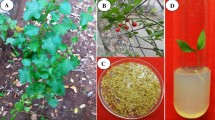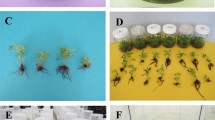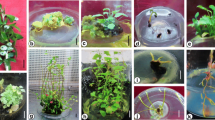Abstract
Rhynchostylis retusa (L.) is an epiphytic orchid with high medicinal and ornamental potential. It is commonly known as ‘Queen of Orchid’ and ‘fox tail orchid’. The present study was designed to standardize an efficient protocol for the mass multiplication of R. retusa and to assess the clonal fidelity of the in vitro regenerated plants. The R. retusa seeds were inoculated into basal MS, half and quarter strength MS medium and showed maximum 89% germination in MS medium after 4-weeks of incubation. The protocorm like bodies were developed from seeds after 6-months of incubation. Protocorms inoculated into MS medium fortified with BAP (4.4 µM) and activated charcoal (2.0 g l−1) were observed to be optimal medium for shoot proliferation in R. retusa and maximum 46.84 shoots with a 6.5 cm shoot length were obtained. The in vitro regenerated shoots exhibit maximum 97.64% root proliferation in half-strength MS medium enriched with activated charcoal (2.0 g l−1) and 7.4 roots per shoot with 6.7 cm root length were obtained. The properly developed plantlets were successfully acclimatized with 80% survival. Clonal stability of the protocol was evaluated by using 20 RAPD markers, which proved true for the typesets of the in vitro raised plants. Thus, the present study optimized an in vitro propagation system for R. retusa which can be successfully applied for germplasm conservation, genetic improvement studies and commercial scale propagation of the species for medicinal and ornamental purposes.




Similar content being viewed by others
References
Al-Amin M, Rahiman SSF, Hossain CF, Khairuddean M, Salhimi SS (2023) Natural products from Rhynchostylis retusa (Orchidaceae), their chemophenetic significance and bioactivity. Biochem Syst Ecol 111:104737. https://doi.org/10.1016/j.bse.2023.104737
Arditti J (1992) Fundamentals of orchid biology. Wiley, New York
Auvira FD, Mercuriani IS, Aloysius S (2021) Genetic variability analysis of terrestrial Spathoglottis plicata orchid variants based on RAPD marker. In: Proceedings of the 7th international conference on research, implementation, and education of mathematics and sciences (ICRIEMS 2020). Atlantis Press, pp 70–75
Bhatnagar M, Sarkar N, Gandharv N, Apang O, Singh S, Ghosal S (2017) Evaluation of antimycobacterial, leishmanicidal and antibacterial activity of three medicinal orchids of Arunachal Pradesh, India. BMC Complement Altern Med 17:379
Bhattacharjee B, Islam SMS (2015) The effect of PGRs on in vitro development of protocorms, regeneration and mass multiplication derived from immature seeds of Rhynchostylis retusa (L.) Blume. G J B B 4(1):121–127
Bhattacharyya P, Kumaria S, Diengdoh R, Tandon P (2014) Genetic stability and phytochemical analysis of the in vitro regenerated plants of Dendrobium nobile Lindl., an endangered medicinal orchid. Meta Gene 2:489–504. https://doi.org/10.1016/j.mgene.2014.06.003
Deb CR, Deb MS, Jamir NS, Imchen T (2009) Orchids in indigenous system of medicine in Nagaland, India. Pleione 3(2):209–211
Devi SY, Neelashree N (2018) Micropropagation of the monopodial orchid, Rhynchostylis retusa (L.). Int J Life Sci 6(1):181–186
Doyle JJ, Doyle JL (1987) A rapid DNA isolation procedure from small quantities of fresh leaf tissue. Phytochem Bull 19:11–15
Jalal JS, Kumar P, Pangtey YP (2008) Ethnomedicinal orchids of Uttarakhand, Western Himalaya. Ethnobot Leafl 12:1227–2123
Joshi R, Shukla A, Kumar P (2013) In vitro water deficit stress induced genotypic alterations in protein profile among aromatic rice varieties. Ann Plant Sci 2:455–458
Kumar A, Mahanty B, Goswami RCD, Barooah PK, Choudhury B (2021) In vitro antidiabetic, antioxidant activities and GC–MS analysis of Rhynchostylis retusa and Euphorbia neriifolia leaf extracts. 3 Biotech 11(7):315. https://doi.org/10.1007/s13205-021-02869-7
Kumar A, Nandi SK, Bag N, Palni LMS (2002) Tissue Culture studies in two important taxa: Rhynchostylis retusa (L.) Bl. and Cymbidium elegans Lindl. Gyanodaya Prakashan, Nainital, India, pp 113–124
Lukens LN, Zhan S (2007) The plant genome’s methylation status and response to stress: implications for plant improvement. Curr Opin Plant Biol 10:317–322
Mondal T, Banerjee N (2017) Micropropagation and in vitro conservation of threatened orchids: a brief review. J Biotechnol 6(3):1–12
Murashige T, Skoog F (1962) A revised medium for rapid growth and bioassays with tobacco tissue cultures. Physiol Plant 15:473–497
Naing AH, Park IS, Hwang YJ, Chung JD, Lim KB (2010) In vitro micropropagation and conservation of Rhynchostylis retusa. Hortic Environ Biotechnol 51(5):440–444
Nongdam P (2014) Ethnomedinal uses of some orchids of Nagalands, North East India. Res J Med Plants 8(3):126–139
Oliya BK, Chand K, Thakuri LS, Baniya MK, Sah AK, Pant B (2021) Assessment of genetic stability of micropropagated plants of Rhynchostylis retusa (L.) using RAPD markers. Sci Hortic 281:110008
Panwar GS, Joshi B, Joshi R (2022) Axenic rhizome culture and clonal fidelity assessment of Eulophia dabia (D. Don) Hochr: an endangered terrestrial orchid species. In Vitro Cell Dev Biol Plant 58:567–576
Parab G, Krishnan S (2012) Rapid in vitro mass multiplication of orchids Aerides maculosa Lindl. and Rhynchostylis retusa Bl. from immature embryo seeds. Indian J Biotechnol 11:288–294
Rahman M, Rajora O (2001) Microsatellite DNA somaclonal variation in micropropagated trembling aspen (Populus tremuloides). Plant Cell Rep 20:531–536
Rani V, Raina SN (2000) Genetic fidelity of organized meristem derived micropropagated plants: a critical reappraisal. In Vitro Cell Dev Biol Plant 36:319–330
Saker M, Bekheet S, Taha H, Fahmy A, Moursy H (2000) Detection of somaclonal variations in tissue culture-derived date palm plants using isoenzyme analysis and RAPD fingerprints. Biol Plant 43(3):347–351
Samarfard S, Kadir MA, Kadzimin SB, Ravanfar S (2013) Genetic stability of in vitro multiplied Phalaenopsis gigantea protocorm-like bodies as affected by chitosan. Not Bot Hortic Agrobot Napoca 41:177–183
Saxena S (2020) The current research status of endangered Rhynchostylis retusa (L.) blume: a review. Asian J Res Bot 4(2):16–25
Shanavaskhan AE, Sivadasan M, Farhan AH, Thomas J (2012) Ethnomedical aspects of angiospermic epiphytes and parasites of Kerala, India. Indian J Trad Know 11(2):250–258
Singh SK, Agarwala DK, Jalal JS, Dash SS, Mao AA, Singh P (2019) Orchids of India—a pictorial guide. Botanical Survey of India, Kolkata
Sinha P, Jahan MAA (2012) Clonal propagation of Rhynchostylis retusa (Lin.) blume through in vitro culture and their establishment in the nursery. Plant Tissue Cult Biotech 22(1):1–11
Sondhi A (2011) Wonders of India: flowers. The Energy and Resources Institute, pp 28–29. https://books.google.co.in/books?id=9oZhwnvsf3kC&pg=PT28&source=gbs_selected_pages&cad=2#v=onepage&q&f=false. Assessed 17 Aug 2023
Subedi A, Kunwar B, Choi Y, Dai Y, Andel TV, Chaudhury RP (2013) Collection and trade of wild-harvested orchids in Nepal. J Ethnobiol Ethnomed 9(1):64–74
Thomas D, Michael A (2007) High-frequency plantlet regeneration and multiple shoot induction from cultured immature seeds of Rhynchostylis retusa Blume., an exquisite orchid. Plant Biotechnol Rep 1:243–249
Tikendra L, Amom T, Nongdam P (2019) Molecular genetic homogeneity assessment of micropropagated Dendrobium moschatum Sw.-a rare medicinal orchid, using RAPD and ISSR markers. Plant Gene 19:100196. https://doi.org/10.1016/j.plgene.2019.100196
Vij SP, Sood A, Plaha KK (1984) Propagation of Rhynchostylis retusa BL. (Orchidaceae) by direct organogenesis from leaf segment cultures. Bot Gaz 145(2):210–214
Yadav K, Aggarwal A, Singh N (2013) Evaluation of genetic fidelity among micropropagated plants of Gloriosa superba L. using DNA-based markers—a potential medicinal plant. Fitoterapia 89:265–270
Acknowledgements
Authors are thankful to the Director, Botanical Survey of India, Kolkata and the Head of Office, Botanical Survey of India, Northern Regional Centre, Dehradun for the infrastructure and financial support.
Author information
Authors and Affiliations
Contributions
BJ carried out the experiment and GSP also carried out experiment, analysed the data and drafted the manuscript.
Corresponding author
Ethics declarations
Conflict of interest
On behalf of all authors, the corresponding author states that there is no conflict of interest.
Additional information
Publisher's Note
Springer Nature remains neutral with regard to jurisdictional claims in published maps and institutional affiliations.
Rights and permissions
Springer Nature or its licensor (e.g. a society or other partner) holds exclusive rights to this article under a publishing agreement with the author(s) or other rightsholder(s); author self-archiving of the accepted manuscript version of this article is solely governed by the terms of such publishing agreement and applicable law.
About this article
Cite this article
Panwar, G.S., Joshi, B. In vitro propagation and clonal fidelity assessment of Rhynchostylis retusa (L.) Blume: a threatened ornamental and medicinal orchid. Vegetos (2024). https://doi.org/10.1007/s42535-024-00831-5
Received:
Revised:
Accepted:
Published:
DOI: https://doi.org/10.1007/s42535-024-00831-5




